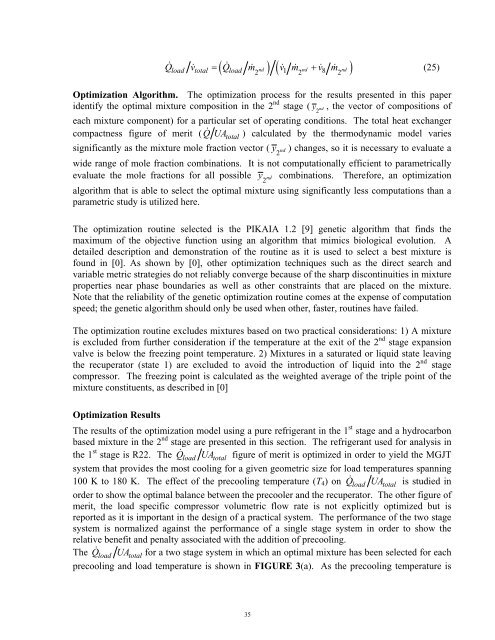Space Grant Consortium - University of Wisconsin - Green Bay
Space Grant Consortium - University of Wisconsin - Green Bay
Space Grant Consortium - University of Wisconsin - Green Bay
Create successful ePaper yourself
Turn your PDF publications into a flip-book with our unique Google optimized e-Paper software.
load total load<br />
( nd ) ( 1 nd 8 nd )<br />
Q� v� = Q� m� v� m� + v� m�<br />
(25)<br />
2 2 2<br />
Optimization Algorithm. The optimization process for the results presented in this paper<br />
identify the optimal mixture composition in the 2 nd stage ( y nd , the vector <strong>of</strong> compositions <strong>of</strong><br />
2<br />
each mixture component) for a particular set <strong>of</strong> operating conditions. The total heat exchanger<br />
compactness figure <strong>of</strong> merit ( QUA �<br />
total ) calculated by the thermodynamic model varies<br />
significantly as the mixture mole fraction vector ( y nd ) changes, so it is necessary to evaluate a<br />
2<br />
wide range <strong>of</strong> mole fraction combinations. It is not computationally efficient to parametrically<br />
evaluate the mole fractions for all possible y nd combinations. Therefore, an optimization<br />
2<br />
algorithm that is able to select the optimal mixture using significantly less computations than a<br />
parametric study is utilized here.<br />
The optimization routine selected is the PIKAIA 1.2 [9] genetic algorithm that finds the<br />
maximum <strong>of</strong> the objective function using an algorithm that mimics biological evolution. A<br />
detailed description and demonstration <strong>of</strong> the routine as it is used to select a best mixture is<br />
found in [0]. As shown by [0], other optimization techniques such as the direct search and<br />
variable metric strategies do not reliably converge because <strong>of</strong> the sharp discontinuities in mixture<br />
properties near phase boundaries as well as other constraints that are placed on the mixture.<br />
Note that the reliability <strong>of</strong> the genetic optimization routine comes at the expense <strong>of</strong> computation<br />
speed; the genetic algorithm should only be used when other, faster, routines have failed.<br />
The optimization routine excludes mixtures based on two practical considerations: 1) A mixture<br />
is excluded from further consideration if the temperature at the exit <strong>of</strong> the 2 nd stage expansion<br />
valve is below the freezing point temperature. 2) Mixtures in a saturated or liquid state leaving<br />
the recuperator (state 1) are excluded to avoid the introduction <strong>of</strong> liquid into the 2 nd stage<br />
compressor. The freezing point is calculated as the weighted average <strong>of</strong> the triple point <strong>of</strong> the<br />
mixture constituents, as described in [0]<br />
Optimization Results<br />
The results <strong>of</strong> the optimization model using a pure refrigerant in the 1 st stage and a hydrocarbon<br />
based mixture in the 2 nd stage are presented in this section. The refrigerant used for analysis in<br />
the 1 st stage is R22. The Q� load UAtotal<br />
figure <strong>of</strong> merit is optimized in order to yield the MGJT<br />
system that provides the most cooling for a given geometric size for load temperatures spanning<br />
100 K to 180 K. The effect <strong>of</strong> the precooling temperature (T4) on Q� load UAtotal<br />
is studied in<br />
order to show the optimal balance between the precooler and the recuperator. The other figure <strong>of</strong><br />
merit, the load specific compressor volumetric flow rate is not explicitly optimized but is<br />
reported as it is important in the design <strong>of</strong> a practical system. The performance <strong>of</strong> the two stage<br />
system is normalized against the performance <strong>of</strong> a single stage system in order to show the<br />
relative benefit and penalty associated with the addition <strong>of</strong> precooling.<br />
The Q� load UAtotal<br />
for a two stage system in which an optimal mixture has been selected for each<br />
precooling and load temperature is shown in FIGURE 3(a). As the precooling temperature is<br />
35

















